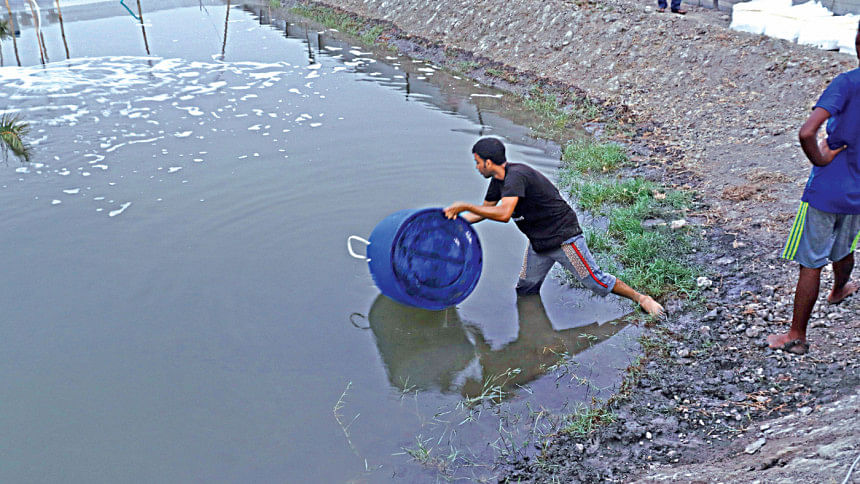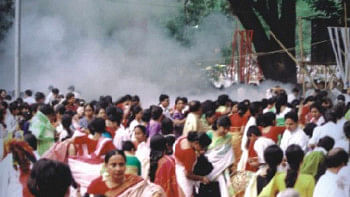Experimental vannamei shrimp cultivation underway

Bangladesh has finally started to farm vannamei shrimp on pilot basis following pleas from exporters as locally grown black tiger shrimp and freshwater prawn are unable to compete with cheaper varieties in western markets.
Purchased from Thailand, the first 10-lakh batch of vannamei was released in four ponds of Bangladesh Fisheries Research Institute (BFRI) in Paikgachha upazila of Khulna.
The project will test whether whiteleg shrimp can cope with the local environment.
If successful, the initiative is expected to breathe life back into the ailing industry.
"One of our main challenges is the shortage of raw materials. We will get raw materials for processing in my factory if our pilot farming is successful," said Shyamal Das, managing director of MU Seafoods.
MU Seafoods partnered with Sushilan, a local non-government organisation, in 2019 to begin the experiment on vannamei farming.
The Department of Fisheries (DoF) gave the go-ahead to culture whiteleg shrimp in the southwestern division of Khulna, a major farming region for export-oriented shrimp, after years of concerns that foreign species may have a negative impact on their native counterparts such as black tiger shrimp.
The project, set to begin last year, had been delayed by early rainfall and the ongoing coronavirus pandemic.
Last year, the fisheries office permitted the Chattogram-based Agribusiness Enterprise Development and Services to cultivate vannamei shrimp in an isolated location at Khuruskul of Cox's Bazar under the supervision of the DoF and Bangladesh Fisheries Research Institute (BFRI).
The firm is yet to complete its procedural documentation to start the pilot farming.
The move comes after repeated pleas from shrimp processors and exporters to allow vannamei cultivation as export earnings from local varieties have fallen consistently since fiscal 2014-15.
This is because local varieties are priced higher than the vannamei farmed in huge quantities mainly in China, Southeast Asia, India and some Latin American regions.
Grown by more than eight lakh farmers on 2.72 lakh hectares of land in Bangladesh's Southwest region to serve consumers in EU and US markets, shrimp fetched Bangladesh about $550 million through its export in fiscal 2013-14.
The receipts dipped to $333 million in fiscal 2019-20, showed data from the Export Promotion Bureau (EPB).
During the July-February period the same year, shrimp exports fell 18 per cent year-on-year to $224 million.
Das said the pilot project gives hope for shrimp processing plants and farmers for better productivity.
MU Seafood invested nearly Tk 1 crore to prepare the ponds for the project.
Company officials said before they released the postlarvae vannamei, samples were sent to the Bangladesh Fisheries Research Institute (BFRI) and Bagerhat Shrimp Research Center for testing.
"The test results will actually tell you when to start the next phase in their growth," said Pabitra Kumar Das, senior fisheries officer of Paikgachha.
He also said the nursing was done at the BFRI ponds to prevent it from coming in contact with the environment and harming it.
Processors said farmers can grow shrimp once a year whereas vannamei can be cultivated three times a year.
At the same time, productivity of vannamei is much higher than shrimp grown in ordinary ponds.
Regular shrimp cultivation yields 300-400 kilogrammes per hectare but in case of vannamei, the yield per hectare is 7,000-8,000 kilogrammes.
"We do not have an alternative to run exports without vannamei cultivation and I think it won't have any effect on the environment," said Mostafa Nuruzzaman, chief executive officer of Sushilan.
Kazi Belayet Hossain, former president of the Bangladesh Frozen Foods Exporters Association, said the production cost of black tiger shrimp is higher than that of vannamei.
"And we are unable to cater to the global market at this price. People want shrimp at cheaper rates," he said.
Hossain added that vannamei was produced in 67 countries and accounted for 77 per cent of the global shrimp production in 2017.

 For all latest news, follow The Daily Star's Google News channel.
For all latest news, follow The Daily Star's Google News channel. 



Comments